News & Podcast
2010 Spring Newsletter
Download PDF
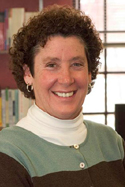
Sunny, spring greetings from the Tucker Center! In this issue of our newsletter you’ll read about the impressive number of scholarly activities our faculty and affiliated scholars are engaged in, ranging from a major grant sponsored by the General Mills Foundation which examines physical activity and healthy eating among African American females, to keynote addresses and publications in prestigious academic journals. These are all key indicators of the important work we are doing and the kind of impact and recognition these efforts are having on a national and international scale.
Because much of the work we do focuses on youth and adolescence, we thought it was a good (and long overdue) time to focus on the other end of the age spectrum. Our spring Distinguished Lecture—featuring renowned speaker and author Mariah Burton Nelson—will explore the intersection of gender, physical activity, and aging. As is her custom, Nelson will challenge how we typically think about aging in general, as well as our own aging process. She will focus in particular on how physical activity can improve one’s quality of life and help to ensure graceful and successful aging. The challenges and opportunities women face as they age across the lifespan are many. We hope to raise awareness and facilitate critical thinking about this highly relevant topic through our Distinguished Lecture and this issue of our newsletter.
Related to Nelson’s presentation is Co-Director Maureen Weiss’ feature story on aging and physical activity. Weiss provides insightful evidence about this important subject—injected with personal reflections on her own aging process—that I’m sure you will truly enjoy. Speaking of aging and physical activity, we all know that the Winter Olympics in Vancouver just concluded in February, but did you also know about the National Senior Games? Learn more about this inspiring yet under-the-radar event in our Did You Know column.
Finally, because of the numerous projects and initiatives happening in the Tucker Center, it is becoming increasingly difficult to fit all our news in the boundaries of this twice-yearly newsletter. We hope you’ll stay connected with us between newsletters by visiting our web site and our other social media outlets. What you will learn there is that the Tucker Center continues to be the leading “go to” authority that local and national news outlets rely on due to our evidence-based expertise regarding sport and gender. Seldom does a week go by where we are not asked to comment on such key issues as Title IX, the scarcity of female coaches, and how sportswomen are portrayed throughout mainstream media. You can find links to these stories and more by visiting the Tucker Center homepage.
—Mary Jo Kane, Director
Step into any greeting-card store and peek at cards specified for ages 50+. You might see one that reads, “I’m smiling and nodding because I have no idea what’s going on.” On the inside reads, “Just one more outcome of getting a year older!” Don’t get me wrong about the card’s message—I have a good sense of humor. But this phenomenon begs the question, “Why do ‘older’ birthday cards carry such doom and gloom?” Is it a universal truth that declines in cognitive and physical health occur with age? In my Developmental Sport and Exercise Psychology course, I once asked my students (ages 22-25) to identify the age range and adjectives for children, adolescents, middle aged, and older adults. The majority wrote down the years 30-55 for middle age, and 55+ for older adults. Older adults received the most negative labels, including loss of physical abilities, declining health, frail, sick, remorseful, abandoned, and dependent. Unfortunately, my students envisioned their futures as older adults in pretty pessimistic ways.
I share these two scenarios—birthday cards and my students’ opinions—to reveal the pervasive stereotypes society holds about getting older and to present an alternative view for how adults can age successfully. My answer is a resounding “No!” to the question of whether health declines are universal with increasing age. There are infinite possibilities for developing a physically active lifestyle and embracing a positive self-perception as an active, healthy adult.
The Physical Activity Guidelines for Americans specify that adults (ages 18-64) and older adults (65 years and older) can achieve substantial health benefits when they participate in at least 150 minutes of moderate-intensity aerobic activity each week. Such activities include walking briskly, swimming, bicycling, dancing, and golfing. Additional health benefits can be achieved by doing 300 minutes of moderate-intensity activity weekly and muscle-strengthening activities on at least two days per week. Muscle-strengthening activities include weight training, calisthenics, yoga, tai chi, and heavy gardening. These guidelines sound rather straightforward. However, one of the barriers to achieving them is that many adult women do not self-identify as physically active; such self-perceptions are associated with sedentary or insufficient activity even though they are aware that being active means being healthy. Understanding women’s self-perceptions is crucial because they are associated with physical activity levels, successful aging, and healthy behaviors.
The concept of “possible selves” (coined by Hazel Markus) is linked with future physical activity behaviors and healthy outcomes. As we age, we often think about the experiences that are in store for us, and the kinds of people we might possibly become. Sometimes we think about what we hope we will be like—our hoped-for possible selves. Hoped-for selves include being a healthy older adult and experiencing quality of life. We may also have images of ourselves in the future that we fear and want to avoid becoming, our feared possible selves. Feared selves might comprise old-age descriptors my students listed—frail, sedentary, and dependent.
To avoid this future of fear, possible strategies include asking yourself, “What am I doing to help achieve (or prevent) this possible self? Do I engage in specific activities to achieve a hoped-for self or avoid a feared self?” Adults who are regularly active ask these questions—and use these strategies—to reach physical activity and nutrition goals. Adult women who are not regularly active, and thus at risk for not aging successfully, can benefit from identifying strategies for achieving possible selves, and seeking support from friends, family, and professionals to help achieve their goals. The bottom line is that self-perception drives behavior—possible selves along with constructive strategies lead to adopting physical activity levels that ensure positive cognitive, emotional, and physical health.
As a Baby Boomer myself, I have hope for the future. I set daily and weekly goals to keep my sights focused on my hoped-for self. I encourage all women to use the “possible selves” strategy to envision their future as a healthy older adult. Recently, I came across a birthday card that captures the take-home message of my story. On the outside it says, “Everyone is the age of their heart…” And on the inside? “Happy birthday, kid.”
—Maureen Weiss, Co-director
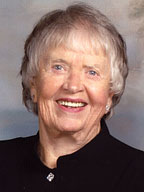 The Tucker Center is the first interdisciplinary research
center in the world leading a multi-faceted effort to explore how sport
and physical activity affect the lives of girls and women, their
families, and communities. It is fitting that this distinctive and
pioneering research center reflects its namesake—Dorothy McNeill Tucker.
Her $1 million gift to the University of Minnesota in the early 1990s
launched an unprecedented moment within the scientific community among
scholars who studied women’s sports, and her financial generosity became
the foundation for the first endowment of its kind in the United States.
Dr. Tucker’s approach to philanthropy is “one of a kind” as well.
“Anybody can endow a chair in economics or psychology; all universities
have those. But I walk to a different drummer, and I wanted my gift to
have real impact,” states Dr. Tucker. Her gift was particularly timely
because 1992 marked the 20th anniversary of Title IX and participation
opportunities for female athletes had skyrocketed. Scholarship related
to the impact of that participation, however, was lagging behind.
According to Mary Jo Kane, the first and only Director of the Tucker
Center, “What was needed was a research center housed within a major
university, one which recognized the significance of sport and physical
activity in women’s lives. It was Dr. Tucker’s vision and generosity
that made this happen, and look at how many people around the world have
benefited because of what she did.”
The Tucker Center is the first interdisciplinary research
center in the world leading a multi-faceted effort to explore how sport
and physical activity affect the lives of girls and women, their
families, and communities. It is fitting that this distinctive and
pioneering research center reflects its namesake—Dorothy McNeill Tucker.
Her $1 million gift to the University of Minnesota in the early 1990s
launched an unprecedented moment within the scientific community among
scholars who studied women’s sports, and her financial generosity became
the foundation for the first endowment of its kind in the United States.
Dr. Tucker’s approach to philanthropy is “one of a kind” as well.
“Anybody can endow a chair in economics or psychology; all universities
have those. But I walk to a different drummer, and I wanted my gift to
have real impact,” states Dr. Tucker. Her gift was particularly timely
because 1992 marked the 20th anniversary of Title IX and participation
opportunities for female athletes had skyrocketed. Scholarship related
to the impact of that participation, however, was lagging behind.
According to Mary Jo Kane, the first and only Director of the Tucker
Center, “What was needed was a research center housed within a major
university, one which recognized the significance of sport and physical
activity in women’s lives. It was Dr. Tucker’s vision and generosity
that made this happen, and look at how many people around the world have
benefited because of what she did.”
What about Dr. Tucker’s background and experience made her so devoted to the University of Minnesota and to women’s sports? For starters, she graduated from the U of M in 1945 where she studied counseling psychology and recreational leadership. “I have great memories of my undergraduate years at Minnesota. The University provided me with a wonderful educational opportunity and helped me pursue a professional career at a time when women weren’t encouraged to do such things.” In the World War II era, few opportunities existed for women to play sports. And though she “loved all kinds of sports,” sorority intramurals were the only sporting option during her time at Minnesota. In spite of this she never complained about gender discrimination. “The inequities were just the way it was back then. It never occurred to us it was going to be any different [in the future].” Being limited in competitive sporting opportunities did not deter her from taking on leadership roles in college. Looking through the pages of Gopher yearbooks, Dr. Tucker was clearly a mover and a shaker on campus. She served as President of her senior class cabinet and was also President of the Panhellenic Council.
After leaving Minnesota, Dr. Tucker went on to earn a Master’s degree in Physical Education from Illinois State University, Normal, and a Doctorate from UCLA. She taught physical education at Western Illinois University and psychology at California State Polytechnic University, where she was the first female faculty member and became the first woman promoted to Full Professor. While at Cal Poly, Dr. Tucker met and married fellow faculty member Elbridge Ashcraft Tucker, who had a second career as a successful industrial appraiser. During their 33 years together, they achieved both professional and personal success. To honor their relationship, Dr. Tucker established the Dorothy McNeill and Elbridge Ashcraft Tucker Chair for Women in Exercise Science & Sport. It remains the only endowed professorship devoted to the study of women’s sports within higher education. Her continued commitment to such causes—not to mention her amazing financial support—has not gone unnoticed by the University of Minnesota. She served with distinction for 12 years on the U of M Foundation’s Board of Trustees, and in 2006 she was named one of the 100 Most Distinguished Alumni of the College of Education and Human Development. Her philosophy of giving is best summed up in the following statement: “I am sure I have received more from the gifts I have given to Minnesota than has the University. The joy of giving is increased tremendously when you can see how your gift is being used during your lifetime.”
It was this sense of “how her gifts were being used” through the accomplishments of the Tucker Center that inspired Dr. Tucker to bequest an additional $1 million endowment in 2001. As a result, we have expanded our research and educational efforts to more thoroughly investigate the various ways sport and physical activity impact females, and to recruit the “best and brightest” faculty and students to come to the U of M. These highly recruited individuals share something in common with Dr. Tucker—a deep and abiding passion for sports. Indeed, Dr. Tucker points out that her love of sports has played an important role in every facet of her life.
After a groundbreaking professional career, Dr. Tucker looked forward to an early retirement so she could spend more time playing golf. “I retired at age 50 and spent the next 15 years being a golf bum! But after one hip and two knee replacements [due to arthritis] my body has betrayed me and I can’t golf anymore.” This has not dampened her love of sports in general and golf in particular. She lives in a house that overlooks a golf course—the very course she and her late husband used to play almost every day. Rest assured that neither retirement nor arthritis has slowed down this energetic and visionary woman: “I’m busier now than ever with my church and community activities.”
Dr. Tucker continues to be busy in other ways as well. This past October, she donated $25,000 to a matching scholarship fund to support graduate studies at the Tucker Center. Her exceptional gift allows us to support outstanding students from around the country to come to the U of M and pursue their graduate work and begin their careers as the next generation of scholars. As Research Assistant and Kinesiology Ph.D. student Austin Calhoun remarks: “Because of the Tucker Center, the U of M was at the top of my list of potential schools to attend, given my research interests in gender and sport. The opportunities I am afforded here are second to none.” As all of us in the Tucker Center know and appreciate, one person really can make a difference!
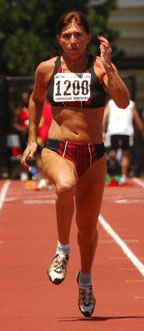 While it was justifiably hard to escape wall-to-wall coverage of the
2010 Winter Olympic Games held in Vancouver, the Senior Games tend to
fly under the radar. But with 100,000 competitors over the last two
decades these games deserve at least some press! And this is a wonderful
example of how to age successfully through involvement in sport and
physical activity.
While it was justifiably hard to escape wall-to-wall coverage of the
2010 Winter Olympic Games held in Vancouver, the Senior Games tend to
fly under the radar. But with 100,000 competitors over the last two
decades these games deserve at least some press! And this is a wonderful
example of how to age successfully through involvement in sport and
physical activity.
Begun in 1987, the Senior Games is the largest multi-sport event in the world for female and male athletes 50 and older. Last held in August 2009 in San Francisco, there are over 800 events in the 16-day competition. Attendance for the 2009 games was just under the record-setting event in 2007, which had 12,100 participants. Athletes can medal in any of the following activities: Archery, Badminton, Basketball, Bowling, Cycling, Golf, Horseshoes, Race Walk, Racquetball, Road Race, Shuffleboard, Softball, Swimming, Table Tennis, Tennis, Track & Field, Triathlon, and Volleyball.
What kind of impact do the Senior Games have? Hall of Fame inductee
and owner of 24 World Records, Phil Raschker from Marietta, Georgia,
says it all: “The Senior Games have given me an opportunity to compete
at the local, state, and national level...and working with the staff of
the Games [has enabled me] to motivate senior men and women to lead a
healthy lifestyle...I am also able to partner with national leaders
committed to senior health, wellness, and quality of life.”
The Senior Games are held biennially with upcoming games taking place in
Houston (2011) and Cleveland (2013). More information about the Senior
Games can be found at the National Senior Games Association’s Web site,
www.nsga.com. Locally, the Minnesota Senior Games will take place in
Alexandria, July 19-22, 2010.
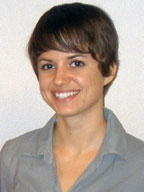 Alyssa Norris joined the Tucker Center in the fall
of 2009 as a Research Assistant under the guidance of her academic
adviser and Tucker Center Associate Director, Nicole LaVoi. Norris
earned a B.A. in Psychology from Princeton University in 2007,
graduating Magna Cum Laude. She comes to the Tucker Center with an
extensive research background, interest in gender issues, and a deep
love of sports. Her senior thesis research—Attribution of Blame to Rape
Victims and Perpetrators: Effects of Gender, Sexual Orientation, and
Sexism—earned Norris the Scientific Research Society Book Award from
Sigma Xi. This professional organization honors excellence in scientific
investigation and membership is by invitation only.
Alyssa Norris joined the Tucker Center in the fall
of 2009 as a Research Assistant under the guidance of her academic
adviser and Tucker Center Associate Director, Nicole LaVoi. Norris
earned a B.A. in Psychology from Princeton University in 2007,
graduating Magna Cum Laude. She comes to the Tucker Center with an
extensive research background, interest in gender issues, and a deep
love of sports. Her senior thesis research—Attribution of Blame to Rape
Victims and Perpetrators: Effects of Gender, Sexual Orientation, and
Sexism—earned Norris the Scientific Research Society Book Award from
Sigma Xi. This professional organization honors excellence in scientific
investigation and membership is by invitation only.
Following graduation, Norris worked as a Research Coordinator for the New York State Psychiatric Institute at Columbia University Medical Center, where she managed a research project on ways to increase the efficacy of cognitive-behavioral treatments for substance abusers. Due to the quality—as well as the breadth and depth—of her work, she was invited by Susan Fiske, an internationally known scholar in the Psychology Department at Princeton, to co-author a chapter titled “Sexism and Heterosexism” which will appear in the forthcoming Cambria Press volume, Aspects of Prejudice: A Handbook.
While at Princeton, Norris played intramural basketball and also served as the president of Club Basketball. In 2002, she completed the Los Angeles Triathlon for Team In Training to raise money for the Leukemia and Lymphoma Society. She is best described as a “passionate fitness enthusiast,” having just earned her National Academy of Sports Medicine Certified Personal Trainer Licensure. At the U of M, she competes in recreational basketball and broomball leagues, and is frequently found completing CrossFit workouts with her fellow graduate students. Her research interests are varied—positive youth development through sports, gendered experiences of collegiate female assistant coaches, and the gendered space usage of recreational fitness centers. Most recently, Norris has taken on a leadership role for a study the Tucker Center is conducting: Media Portrayals of Men’s and Women’s Collegiate Basketball Coaches featured on ESPN.com. It is an understatement to say the Alyssa Norris is a great addition to The Tucker Team!
Honors & Awards
Affiliated Scholar Daheia Barr-Anderson was awarded a one-year, $100,000 Twin Cities Community Action Grant funded by the General Mills Foundation. The grant will support Barr-Anderson’s study—“A Family Affair”—designed to develop and test intervention components of a home-based, physical activity and healthy eating program for African American adolescent girls and their mothers. The study’s primary goal is to increase girls’ daily physical activity, decrease sedentary behavior, and increase healthy eating. A secondary aim of this research is to increase physical activity and healthy eating among the young girls’ mothers.
Affiliated Scholar Jo Ann Buysse recently received a U of M travel grant to visit the Dominican Republic this March. Buysse will meet with sports professionals and arrange site visits for a new learning abroad Kinesiology course on Sport, Globalization, and Human Capital. The Minnesota Twins Baseball Academy located in Boca Chica, and the Dominican Sports & Education Association in Santo Domingo are two of the locations Buysse will also visit as part of her travel grant.
Scholarly Activities
-
Director Mary Jo Kane has two journal articles in press. The first article, “We Have Passed This Way Before: Dollar Dilemmas During the Financial Downturn in College Sports,” will be published in the Journal of Intercollegiate Sport. The second article, “Expanding the Boundaries of Sport Media Research: Using Critical Theory to Explore Consumer Responses to Representations of Women’s Sports,” will appear in the Journal of Sport Management. Kane co-authored the second paper with Affiliated Scholar Heather Maxwell.
-
Kane and Associate Director Nicole LaVoi have a book chapter in press—“Sociological Aspects of Sport and Physical Activity”—which will appear in the 4th edition of Contemporary Sport Management from Human Kinetics.
-
Co-director Maureen Weiss, along with co-authors Tony Amorose and Anna Marie Wilko, published a manuscript in Pediatric Exercise Science titled, “Coaching Behaviors, Motivational Climate, and Psychosocial Outcomes Among Female Adolescent Athletes.”
-
LaVoi published an article in the Women in Sport & Physical Activity Journal titled, “Occupational Sex Segregation in a Youth Soccer Organization: Females in Positions of Power.”
-
Weiss and Nicole Bolter, doctoral candidate, have a book chapter in press, “Moral and Motor Development,” to be published in Human Motor Development: A Lifespan Perspective.
-
Weiss and Affiliated Scholar Diane Wiese-Bjornstal published “Promoting Positive Youth Development Through Physical Activity” in the September 2009 issue of the President’s Council on Physical Fitness and Sports Research Digest.
-
Chapter 2 of the 2007 Tucker Center Research Report, Developing Physically Active Girls: An Evidence-based Multidisciplinary Approach, written by Wiese-Bjornstal, has been reprinted in an edited anthology of writings on girls and women in sport, Women, Sport and Physical Activity: Challenges and Triumphs (2nd ed.).
-
LaVoi has a book chapter, “Athletics as Solution and Problem: Sports Participation for Girls and the Sexualization of Female Athletes,” in press with Elizabeth Daniels, University of Oregon. The chapter will appear in The Sexualization of Girls and Girlhood, a book produced by the American Psychological Association.
Presentations
-
Weiss, Lindsay Kipp, doctoral student, and David Goodman, presented their research, “Unsportsmanlike Aggression in Youth Hockey: Attitudes, Perceived Social Approval, Situational Temptation, and Role Models,” at the Sport Canada Research Initiative Conference in Ottawa, Ontario, November, 2009.
-
Weiss gave a keynote presentation at Girls on the Run Summit, “Promoting Life Skills and Healthy Outcomes in Girls: Benefits of a Physically Active Lifestyle,” in Austin, Texas, in January, 2010.
-
LaVoi was an invited speaker for St. Cloud State Women’s Center Women on Wednesdays (WOW) Lecture Series in celebration of National Girls & Women in Sports Day, February, 2010. She delivered a similar presentation—“Current Issues of Girls & Women in Sport”—to the St. Paul chapter of the AAUW, in March, 2010.
For more information on what members of the Tucker Center are doing, visit the Tucker Center news blog or our Twitter site ...
Mariah Burton Nelson
I’m going to wear sneakers. When I return to Cowles Auditorium to give a presentation on April 21, I’m going to wear sneakers because sneakers permit me the most freedom of movement, and freedom of expression. The topic of my talk is “Are Women Aging Successfully?” I will answer part of that complicated question right now by saying that if women are not comfortable in their own bodies, and are not free to move, express, and dress themselves as they please, then they really can’t be described as aging successfully—can they?
So I’m planning to wear sneakers—to embody my message to you, and also to be ready for anything. I hope you attend, and I hope you wear sneakers too, if they suit you. That way, if I demonstrate an exercise or game related to women and aging, and those of you in the audience feel inspired to try it out for yourself, you’ll be ready. If you can’t attend, wear sneakers to wherever you may be going that day.
In the 15 years since I last spoke as part of the Tucker Center’s
Distinguished Lecture Series (about my second book, The Stronger Women
Get, The More Men Love Football), I’ve spent a lot of time thinking,
reading, and writing about women, aging, and physical activity. I’ve
also been conducting my own “experiment of one,” as fitness guru George
Sheehan so memorably called it. I look forward to sharing the latest
research, and my most recent thinking and experiences, with you. I’ll
offer guidelines for daily physical activity, challenge you to consider
ageist assumptions you might be making, and urge you to conduct an
“experiment of one” with your own body, no matter how old you are.
Here are some highlights from the presentation:
- Review the health problem: Despite Title IX and the fitness revolution, many women are stiff, sore, overweight, and out of shape. The older we get, the more vulnerable we become to heart disease, cancer, stroke, osteoporosis, and injuries from falls. Older women of color suffer from disease and disability even more than white women. Of course, we will all die eventually from something. But many fatal diseases occur prematurely as a direct result of inactivity.
- Consider the social and psychological dimensions of the problem: Gerontophobia (irrational fear of old people or aging) further injures women by equating aging with ugliness and shame. I love the term gerontophobe because it sounds like a dinosaur—and thus alludes to a huge, scary mythic creature that still has power over us.
- Commit to the solution: Learn exactly which daily exercises maintain fitness and health.
- Celebrate the connection between cognitive functioning (including memory and learning) and physical activity: Learn a mnemonic that will ensure you never forget where you parked your car again.
- Take an important step: Develop your own “physical intelligence.”
- Hear inspiring stories of older women: Learn to re-frame your own aging story.
- Experiment with play-based fitness: Live life so that physical activity becomes a treat, not a chore.
I’ll present the latest research findings—which are quite encouraging—but research has its greatest impact when put into practice. My goal for the Distinguished Lecture is to make this research meaningful by giving you opportunities to apply it to your own lives.
Wednesday, April 21, 7-9:00 PM
Hubert H. Humphrey Center, West Bank Campus
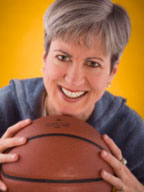 About the Distinguished Lecture
About the Distinguished Lecture
The world’s population is rapidly aging. By 2030, the number of U.S. citizens over 65 will be nearly twice what it is today and a large majority will be women. This gender difference in longevity has significant implications for women’s health, well-being, and quality of life. Scholars and advocates argue that older women are disproportionately affected by ageism and that cultural factors pressure many aging women to focus more on appearance versus physical health, more on face-lifting than weight-lifting. Mariah Burton Nelson, an internationally known author and journalist who currently serves as the Executive Director of the American Association for Physical Activity and Recreation, will challenge us to ask how women can positively embrace growing older and simultaneously resist the detrimental societal forces which may negatively impact their lives. A provocative thinker and writer, Nelson will provide an inspirational look at how women can reframe ageism and redefine “successful aging.” She will discuss the latest research pertaining to personal behaviors that contribute to maintaining and enhancing physical ability, cognitive function, vitality, and joy as we grow older. She will also explore how we think and speak about aging and our own aging process, and encourage us to include stories about hope, humor, health, and happiness.
About the Speaker
Mariah Burton Nelson is the author of six books, including The Stronger Women Get, The More Men Love Football. A former Stanford and professional basketball standout, Nelson is an expert on issues related to gender and sports. She has written for The New York Times, The Washington Post, USA Today, Newsweek, and Ms., and has appeared on numerous television shows including Today, Good Morning America, Dateline, and Larry King Live. A former director of the speechwriting team at AARP, Nelson joined the Gray Panthers while still in her twenties, indicative of a lifelong interest in and commitment to women and aging. In 2007, Nelson was named one of the 100 Most Influential Sports Educators by the International Institute for Sport.
Visit the Tucker Center's online multimedia archive of past Distinguished Lectures with streaming video, PowerPoint presentations, and other informative resources from a variety of topics related to gender and sport.

